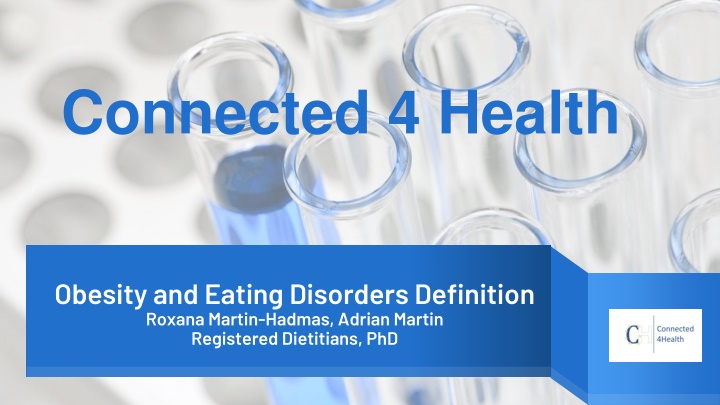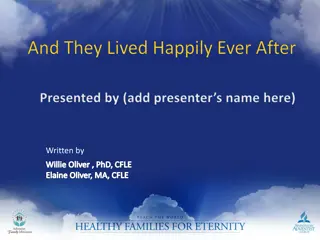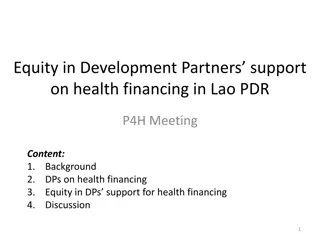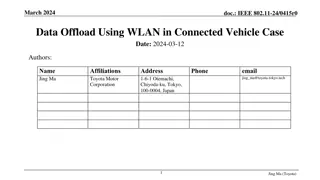Connected 4 Health
Roxana Martin-Hadmas and Adrian Martin, Registered Dietitians with a PhD, present a comprehensive overview of obesity, including definitions, body mass index interpretation, worldwide incidence, and more. Explore the impact, prevalence, and health risks associated with obesity as discussed in this informative presentation supported by the European Commission.
Download Presentation

Please find below an Image/Link to download the presentation.
The content on the website is provided AS IS for your information and personal use only. It may not be sold, licensed, or shared on other websites without obtaining consent from the author.If you encounter any issues during the download, it is possible that the publisher has removed the file from their server.
You are allowed to download the files provided on this website for personal or commercial use, subject to the condition that they are used lawfully. All files are the property of their respective owners.
The content on the website is provided AS IS for your information and personal use only. It may not be sold, licensed, or shared on other websites without obtaining consent from the author.
E N D
Presentation Transcript
Connected 4 Health Obesity and Eating Disorders Definition Roxana Martin-Hadmas, Adrian Martin Registered Dietitians, PhD
Project Number: 2021-1-RO01- KA220-HED-38B739A3 The European Commission's support for the production of this presentation does not constitute an endorsement of the contents, which reflect the views only of the authors, and the Commission cannot be held responsible for any use which may be made of the information contained therein. 2
Project Number: 2021-1-RO01- KA220-HED-38B739A3 The European Commission's support for the production of this presentation does not constitute an endorsement of the contents, which reflect the views only of the authors, and the Commission cannot be held responsible for any use which may be made of the information contained therein. 3
Obesity definition According to the World Health Organization (WHO), obesity represents an excessive accumulation of adipose tissue (fat mass), a change considered abnormal and with health risks. 5
Body mass index From a theoretical point of view, this category includes people with a Body Mass Index (BMI) over 30 kg/m . Body Mass Index Body Mass Index (kg/m ) (kg/m ) Interpretation Interpretation <18.5 Underweight 18.5 24.9 Normal range 25 29.9 Overweight / preobese 30 34.9 Obese, class I 35.0 39.9 Obese, class II >40.0 Obese, class III 6
Worldwide incidence The increase in the prevalence of obesity worldwide has reached epidemic proportions According to a WHO report from 2017 over 4 million deaths are due to excess weight annually 7
Incidence and evolution 2010 2020 2025 2030 % 15 22 23 26 Both gender 11.5 17 18 20 Male 19 25 27 30 Female 8
Etiology The causes are multiple, obesity being a multifactorial disease The most well-known and frequent cause is food excess: a higher caloric intake than the individual needs, along with an imbalance in macronutrient consumption 9
Etiology Other causes: Quality, balance, and diversity of ingested nutrients (beginning perinatally and then throughout the life cycle) Inactivity (sedentarism) Stress, inadequate sleep, and chronic fatigue Risk behaviors (excess of alcohol, social and psycho-emotional maladjustment) Increased leptin levels and leptin resistance 10
Etiology Other causes: POMC (proopiomelanocortin) deficiency Mutations in the MC4R gene (melanocortin-4 receptor) and the FTO, ADRB2, ADRB3, PLIN, DRD2 genes Chromosomal defects and genetic syndromes (Prader-Willi syndrome, Down syndrome, Bardet-Biedl syndrome, Alstrom syndrome, Cornelia de Lange syndrome) Production of hormones at the gastrointestinal level (ghrelin, GLP-1, CCK, PYY, FGF19) 11
Etiology Known effect on appetite Known effect on weight Effect on the energy requirement Ghrelin +++ + Unknown FGF19 Unknown - + GLP-1 --- -- Unknown PYY -- - + CCK - - Unknown 12
Etiology Other causes: Intestinal dysbiosis (reduction in the number ofBacteroides and Bifidobacterium, also increase prevalence of Firmicutes, Lactobacillusand Clostridium) Endocrine disruptors: phthalates, bisphenols (BPA), persistent organic pollutants 13
Misconceptions Obesity is only caused by lack of physical activity and unhealthy eating habits Although diet and sedentary lifestyle are two of the most frequent influencing factors in the appearance of excess weight, they are not the only factors involved in the appearance of anthropometric imbalance The focus is usually on these two indicators because they are the modifiable ones 14
Misconceptions Obese individuals are less active than normal weight individuals Based on the latest research, less than 10% of children and adolescents reach their ideal level of physical activity, while overweight females tend to take more steps per day than those of normal weight 15
Misconceptions Diets work in the long run Large studies conducted on large samples of subjects show that 2/3 of individuals who lose weight regain it within a year and almost all will return to their previous weight within 5 years Thus, maintaining your target weight long-term tends to be more difficult than losing weight itself 16
Misconceptions Weight reduction has no significant negative effects Total weight reduction involves the homeostatic adaptation of the body and more The process of weight rebalancing increases stress levels 17
Misconceptions Exercise is more important than diet in weight loss Weight reduction only by increasing the level of physical activity, in the absence of an adapted diet, is small/medium (below 2 kg) Although physical activity is essential for maintaining good health, it is not sufficient for maintaining an optimal weight 18
Misconceptions The evaluation of a weight reduction program is based on the weight lost Evaluating a program by these methods will increase the incidence of depression, eating disorders, and stigma According to current recommendations, assessment should focus on health benefits, not weight gained/weight lost 19
Lifestyle medicine as part of obesity management (1) The realistic approach: Ask Ask ask permission to discuss weight Assess Assess perform anthropometric determinations and identify possible complications and barriers Advise Advise discuss the benefits of weight rebalancing and treatment options Establish Establish a realistic weight loss with a treatment tailored to the patient Assist Assist assist the patient in the long-term process of weight rebalancing through the necessary means available (constant assessment, provision of informational resources, adaptation) 20
Lifestyle medicine as part of obesity management (2) Multimodal management of obesity Diagnosis of obesity (anthropometric tests, malnutrition scores, laboratory analyses, genetic and epigenetic, metabolomic or gut microbiome tests) followed by identification of associated risks (detailed medical history) 2. Setting realistic goals 3. Involvement in an adapted sport activity 4. Dietary and hydration support 5. Behavioral therapy 1. 21
Lifestyle medicine as part of obesity management (3) 6. Drug therapy (when obesity reaches a high level or comorbidities appear) 7. Surgical intervention (when at least 2 comorbidities are present and dietary + drug therapy has failed) 8. Involvement of family members for support 9. Psychological support, empathy, avoidance of stigma (group or individual therapy) 10. Monitoring and Maintenance 22
Bibliography Chaput JP, Ferraro ZM, Prud'homme D, Sharma AM. Widespread misconceptions about obesity. Can Fam Physician. 2014, 60(11):973-5, 981-4 Mahmoud R, Kimonis V, Butler MG. Genetics of Obesity in Humans: A Clinical Review. Int. J. Mol. Sci. 2022, 23:11005 NCD Risk Factor Collaboration. UN Population Division and World Obesity Federation projections. 2017 Freemark M.S. Pediatric Obesity, Etiology, Pathogenesis and Treatment, Second edition. Humana Press. 2018, ISBN 978-3- 319-68191-7 World Obesity Federation. World Obesity Atlas 2022 , London, 2022 Grief SN, Waterman M. Approach to Obesity Management in the Primary Care Setting. J Obes Weight-Loss Medication. 2019, 5:1024 Forgione N, Deed G, Kilov G et al. Managing Obesity in Primary Care: Breaking Down the Barriers. Adv Ther 2018, 35:191 198 MacKay H, Gunasekara CJ, Yam KY, et al. Sex-specific epigenetic development in the mouse hypothalamic arcuate nucleus pinpoints human genomic regions associated with body mass index. Sci Adv. 2022, 8(39):eabo3991. Eurostat. Body mass index (BMI) by sex, age and income quintile 2019, available at https://appsso.eurostat.ec.europa.eu/nui/show.do?dataset=hlth_ehis_bm1i&lang=en https://www.verywellmind.com/difference-between-disordered-eating-and-eating-disorders-5184548 23























